The Chute
A chute is a long and narrow aisle that forces the sheep to walk in a single file. If you only have a few sheep, you can probably get away with using a solid pen. The larger the flock, however, the more a chute becomes helpful or even necessary.
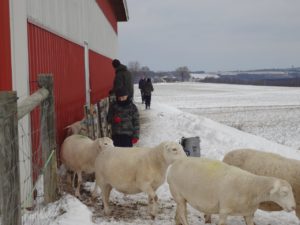
One of our kids counting the sheep as they leave, two others getting them to move up, while I am sorting sheep at the door into the barn. Photo by Ulf Kintzel.
The chute can be used for a variety of purposes, such as sorting, vaccinating, counting, or marking sheep. The chute consists of three elements: the actual chute itself, a holding pen before the chute, and another pen or fenced pasture after the chute. The chute needs to be built from solid panels. The holding pens can be made from temporary fencing, like electric nettings, with only the part closest to the entrance to the chute being solid (as there might be some physical pressure against the pen in this area). This part narrows like a funnel as it gets closer to the chute.
In German, the chute is called “trichter,” which translates into “funnel”. Sounds appropriate, doesn’t it?
I placed my chute, like many of my colleagues in Germany, alongside the barn. This eliminates the need for one side of panels. It also allows me to sort sheep right into the barn (I had a door put in along that side of the barn for just that purpose). The panels for the chute are made from rough-cut Hemlock. Hemlock, although quite light and flexible, is very solid under pressure. In fact, it bends almost elastically when sheep push against it – even more so once the lumber has dried out.
The panels should be about 10 to 12 feet long and 42 inches high. Higher panels may be necessary if your sheep are tall. However, panels that are too high can limit your ability to reach into the chute from the outside. The spacing in between the panel boards should be between 3 ½ to 4 inches at the lower half and 5 inches at the upper half. The reason that the bottom boards are more tightly spaced is to keep lambs from escaping through the spacing.
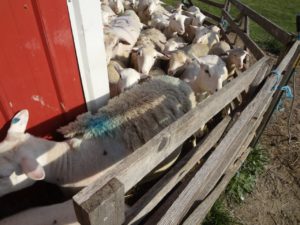
The entrance to the chute. Photo by Ulf Kintzel.
The width of the chute depends on the size of your sheep. Unfortunately, there isn’t a one-size-fits-all width. You will need a narrower chute for lambs than for adult sheep, a wider chute for ewes with full wool than sheep that are shorn. Additionally, you will want to be able to move through the chute against the sheep as well, such as when you de-worm the flock. You could, of course, adjust the chute accordingly, but this is not always practical. As a general rule of thumb, your ewes should not be able to turn around. At the same time, your chute should not be so narrow that it is uncomfortable for the flock to move through, and they should do so willingly. My chute is between 20 and 22 inches wide. This is just right for my ewes, even when I am in the chute with them.
The panels need to be aligned so that the overlapping panels go with the flow of the flock (see picture) so that the sheep don’t bump their shoulders. Again, the chute should be as comfortable as possible to ensure that the flock is willing to pass through it. My chute is about 90 feet long. If in doubt, make it longer. You won’t have to fill and empty the chute as often. A guillotine gate at the entrance to the chute is very helpful and I think a worthwhile expense. It isn’t necessary, however, and you can also build a regular gate.
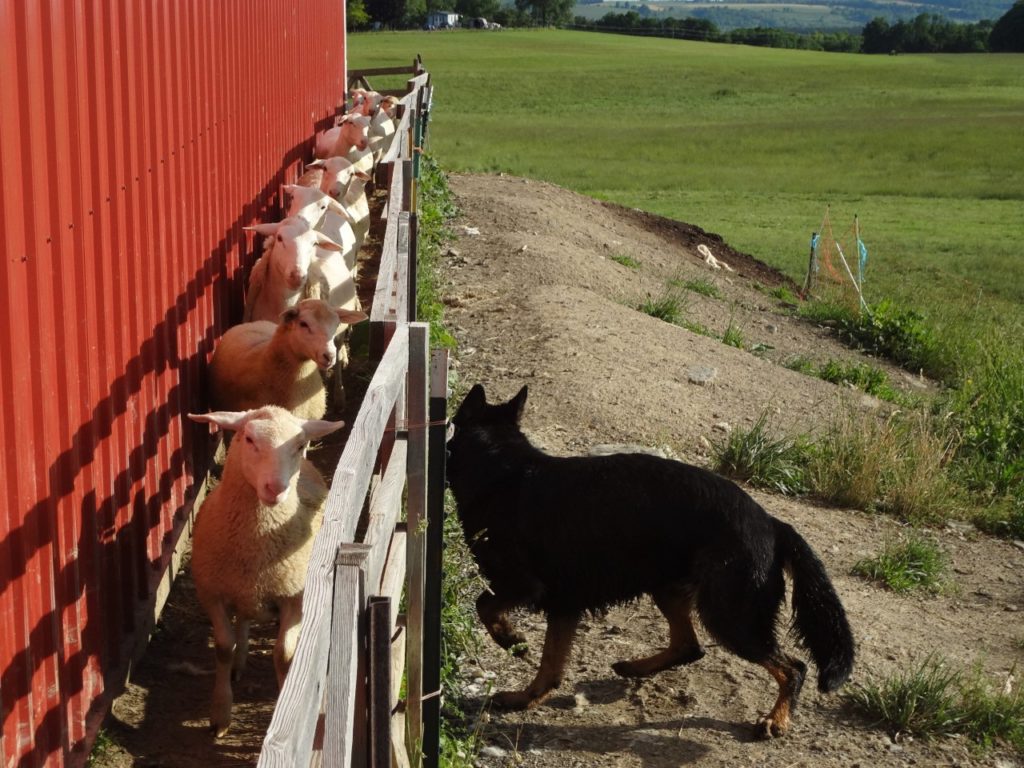
Using a dog to move the sheep up. Please note how the panels overlap! Photo by Ulf Kintzel.
So far I have discussed the equipment and set up. But how do you move the sheep into and through the chute? It pays off to be smart, rather than forceful. Have you ever been to a sales barn where the staff hollers and whistles to get the sheep moving? And what do the sheep do? They balk, refuse, or turn around. It seems that the best kept secret in moving sheep is to keep quiet. Furthermore, when moving sheep into the chute, you might need to give them a little push from the side or rear. However, you should never touch any part of the front of the sheep or pull them forward. This will only make them back up. If this is totally new to you and your sheep, you may need to catch the first sheep and push it into the chute, after which the others will be more likely to follow.
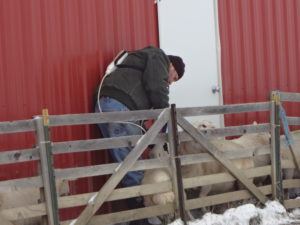
De-worming the sheep, moving against them. Photo by Ulf Kintzel.
Also, the first time you need the chute should not be the first time you use the chute. Be sure to let the sheep just run through for practice, without doing anything other than perhaps counting them. This will help the sheep get comfortable with moving through the chute. It also helps if you provide the sheep an incentive to get to the other end of the chute, such as good pasture or some grain. If the sheep are hungry, even better.
Lastly, the first time you use your chute, it helps to work with adult sheep – they move more easily than lambs. And remember that ewes with young lambs are the hardest to get through a chute. Whatever you do, be smart and think like a sheep does.

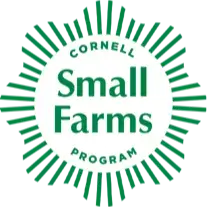
Thank you!
Nice article. Just what I was looking for.
Keep up the good work!
Great, practical info. Thank you!
thanks for the summary, right in line with my experience. I always underestimate how narrow the sheep turning radius is,thus I keep making it possible for one balky but very flexible sheep to turn around and gum up the entire works!
All helpful info